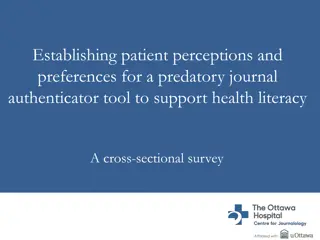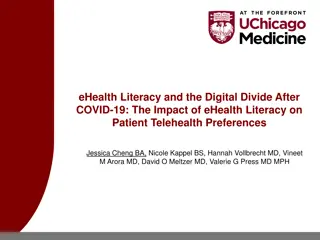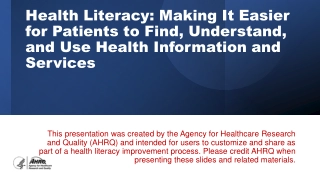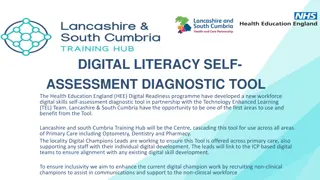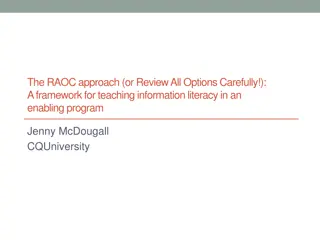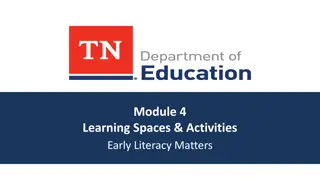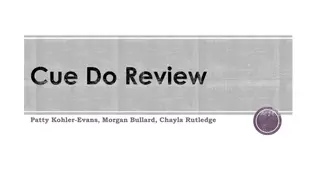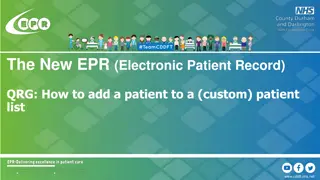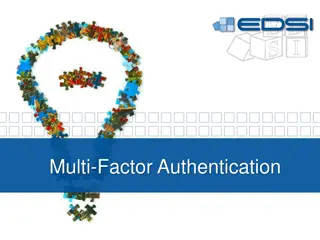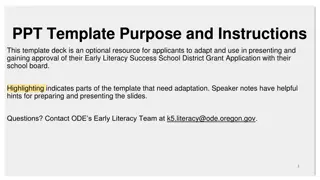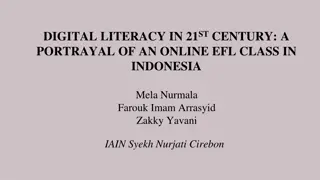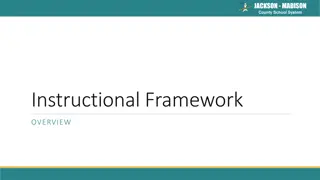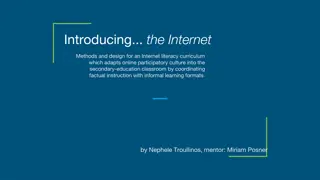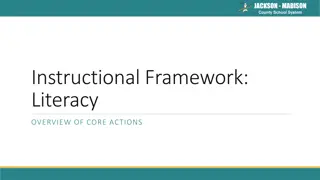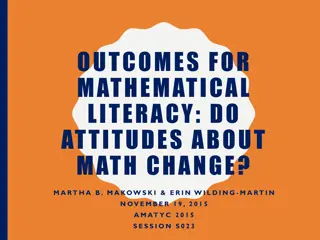Patient Perceptions on Journal Authenticator Tool for Health Literacy
This study focuses on patient perceptions and preferences regarding a journal authenticator tool to support health literacy. Through focus groups, patients provided input on the tool's features, design, sharing methods, and tracking impact. Key findings emphasized the importance of credibility details, user-friendly display, patient-centered outreach for sharing, and user metrics for tracking success.
Download Presentation

Please find below an Image/Link to download the presentation.
The content on the website is provided AS IS for your information and personal use only. It may not be sold, licensed, or shared on other websites without obtaining consent from the author. Download presentation by click this link. If you encounter any issues during the download, it is possible that the publisher has removed the file from their server.
E N D
Presentation Transcript
Establishing patient perceptions and preferences for a predatory journal authenticator tool to support health literacy A focus group study
Objective In this part of our research program we obtained input from patients on the journal authenticator tool in two ways. According to CIHR, patient is includes any individual with personal experience of a health issue, informal caregivers, and members of the public. In the second part of this study, we conducted online focus groups to help us determine if patients would find a journal authenticator tool useful and if so, how to design a tool that would be relevant and useful to them.
Methodology 29 participants were recruited from an online survey about how patients use the internet to look for health information 10 focus groups were then conducted to determine if patients would find a journal authenticator tool useful and if so, how to design a tool that would be relevant and useful to them.
Our focus groups determined What content participants would like to see included in a journal authenticator How they would like information to be visually displayed within the tool How to share this tool within the patient community How to track the impact of this journal authenticator tool amongst the patient community
Analysis Focus group results were analyzed using thematic content analysis where researchers independently identified key themes in the data and then discussed until a consensus was reached.
Results Key Findings 1) The most important feature the authenticator tool should have is that it provide details on journal features that indicate credibility 3) Patients stated that the best way to share this tool within the community is through patient-centered outreach and media platforms 2) The authenticator should have an intuitive user-friendly display and use non-technical language 4) Patients thought the best way to track the successfulness of the tool us through built-in user metrics and user feedback
What sort of features would you like a journal authenticator tool to have that could help you make a decision about whether you can trust a particular health research article or not? Details about referencing and citations Journal features that indicate lack of credibility Information about peer-review Institutions/ affiliations associated with the work Journal features that indicate credibility Details about who the authors are Funders/sponsors of the research and/or any conflicts of interest Provide a summary of study methods
If you were to use a journal authenticator tool, how would you like it to look/feel? Provide details on how to access the tool and information Use non-technical language Visually appealing Provide organized visual output of the results assessing a journal Safe to access for the user Have the ability to filter results Should have an intuitive user- friendly display Should be easily accessible
How do you think we should tell people about the journal authenticator tool? Through the academic community Through learning institutions and/or hospitals Through media platforms Through health and NGO organizations Through patient- centered outreach Through health professionals By making it available on search engines Through offering public education By ensuring that it is accessible to all
What type of feedback would help us determine if the tool is successful? Built-in user metrics Health professional and researchers feedback User feedback
Conclusion Results from our focus group indicate that patients would like a journal authenticator tool and that it would provide value to the patient community. The next step in developing this journal authenticator tool is to collect ideas and preferences from another key stakeholder group publishers.
Project team: Greg Bryson Kelly Cobey Agnes Grudniewicz Michael Halas Manoj Lalu David Moher Laurie Proulx Alicia Ricketts Gisell Castillo Thank you to all participants who completed our focus groups If you have any questions, please reach out to Dr. Kelly Cobey (kcobey@ohri.ca) or Dr. Manoj Lalu (mlalu@toh.ca)


